Photos: Kip Miller
No other
country in the world can compete with Morocco's spectacular North African
location. Lapping both the Atlantic Ocean and the Mediterranean Sea, this
westernmost land of the Moslem world also boasts three mountain ranges,
the Sahara's endless golden sands, and four imperial cities. I have had
an intense fascination with this exotic country, also known as d'al Maghreb
al Aqsa (the land of the setting sun), ever since my childhood years in
Palestine, when the first immigrants from the Maghreb arrived, adding
their aromatic cuisine to the bland table that existed in Israel prior
to statehood
It's 1974 and we have not had a vacation by ourselves for several years.
"I think we should do it," says my husband. "We'll hire
Mrs. Russell, the trusted neighborhood nanny who is adored by all children
and parents." Fortunately, Mrs. Russell, who brings along her adorable
dog on all assignments, is available in mid-May, so we sign up for a bargain-priced
fly-drive to Morocco that includes a compact rental car and first-night
accommodations in Casablanca, where we land. Philadelphia and our home
in Villanova seem far, far away as we take our place in a long line going
through customs.
"You
were born in Israel?" asks the dour inspector in passport control.
"Yes," I reply. "But I am an American citizen now."
He scratches his head and takes my passport to an inner office. "I
don't know what kind of relations, if any, Morocco has with Israel these
days," I whisper nervously to my husband. We wait and wait. Half
an hour later, the inspector reappears, a hint of a smile plastered on
his face. "You may now proceed. Be sure to obey all traffic signs
when driving." Both of us let out a sigh of relief. It's nearly noon
when we pick up our rental car, a tiny yellow Renault Five with doors
attached by leather straps. Our fly-drive package also includes first
night's accommodations at the Royal Mansour Meridien, an elegant old hotel
on the Avenue des Forces Royales. "Let's take a walk in the neighborhood
to get a sense of the place," says my husband. My pre-conceived image
of Casablanca has forever been shaped the academy award-winning film that
took place at Rick's Café, the popular nightclub that was fabricated
on the Warner Brothers lot, and the brilliant performances by Humphrey
Bogart, Ingrid Bergman and Paul Henreid, not to mention Claude Rains and
Peter Lorre. The real Casablanca is a bustling city with broad boulevards
and modern shops. Place Mohammed easily evokes Trafalgar Square, in sharp
contrast to the old, walled medina neighborhood packed with tiny shops
and stalls where traditional handicrafts are fabricated and sold. "Overall
this city is quite modern, yet Europe it is not," I whisper to my
husband as we stroll past two robed locals wearing fezes and babouche
slippers.
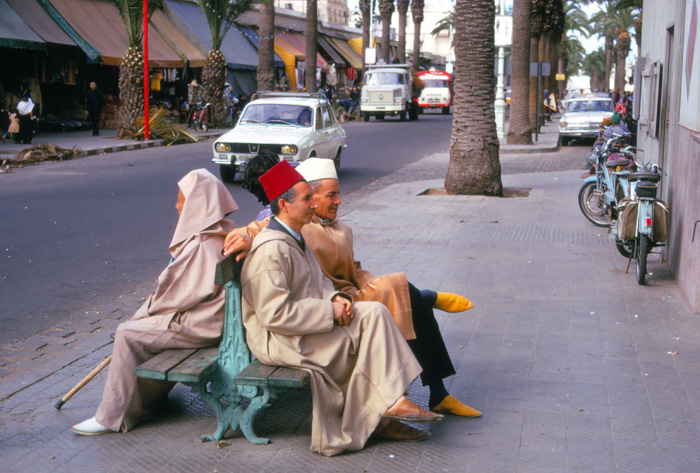
In modern Casablanca, locals still wear traditional fezes and babouche slippers.
We return to our hotel in time for a much-needed nap before dinner. The Royal Mansour is known for its traditional restaurant serving classic Moroccan fare. I survey the room artfully hung with copperware and characteristic blue and white pottery. We opt to sit on chairs, forsaking the customary floor cushions preferred by locals. It is not our first Moroccan feast, but it exceeds our expectations by leaps and bounds. From a variety of aromatic salads with oranges, radishes, cucumbers, herbs and eggplant to a hearty harira soup made with lentils, chickpeas and tomatoes to an exquisite bstilla pastry filled with pigeon and almonds enveloped in filo-like ouarka leaves and dusted with cinnamon and sugar, we find ourselves almost inhaling it all. "This is perfumed cookery," I exult as our final dish, a platter piled high with couscous and tangy vegetables arrives. "This meal is just the tip of the iceberg," I remark to my husband with loud enthusiasm as diners at the next table gape at us. "There are many delectable braised stews known as tagines, a fire-roasted lamb called mechoui, and a huge variety of pastries to try on other occasions." "And I look forward to trying all of them," he replies with a big smile.
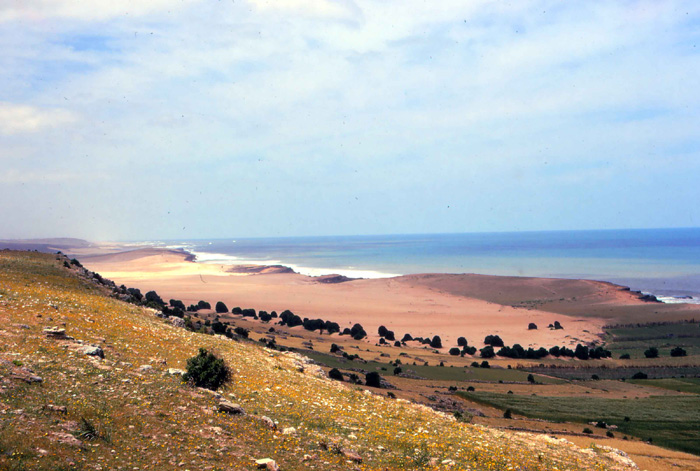
Morocco's sandy shores are deep, rising onto plateaus along the Atlantic Ocean.
We start out early tracing the Atlantic coastline south to Essaouira. Once the haunt of Phoenicians and Carthaginians, this city rises on a peninsula just meters above sea level. At high tide it almost becomes an island. Here the old medina proudly ranks as a UNESCO World Heritage site. We head to the old port lined with hundreds of fishing boats, all painted blue. The place has a timeless medieval air, one of several locations in Morocco ideally suited for filming historical dramas. At a crowded fish stall, we find ourselves almost inhaling a delectable dish of grilled sardines. "Essaouira is the sardine capital of the world," explains the attendant in broken English mixed with French, pleased that we like his fish. Not far away from the port are numerous tiny workshops where inlaid cabinetry and pottery are turned out.
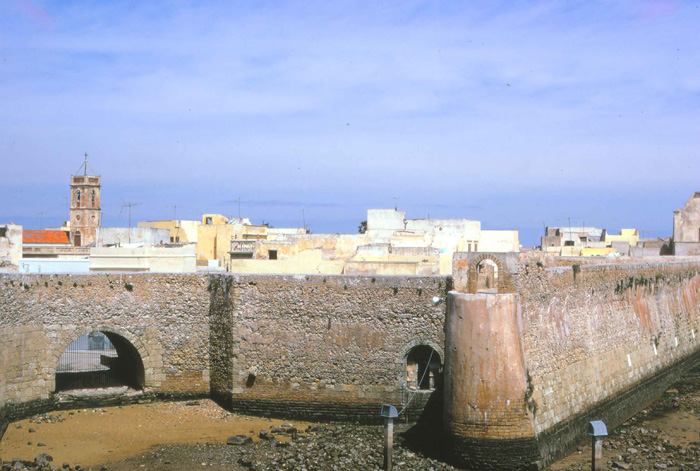
Essaouira becomes an island at high tide
By late afternoon we reach Agadir, a city famous for its spectacular beaches. "Avez vous une chambre pour deux?" I ask the desk attendant at small modern hotel near the beach. "Mais oui," he responds. I am pleased that most Moroccans understand basic French and are not limited to Arabic or one of several Berber dialects, the tongue of the country's original inhabitants. We head to the city's largest beach early in the morning. Agadir ranks as one of the world's best spots for surfing, with spectacular waves that crash on its beaches during the winter months. The ocean swells are much diminished in May, but we can spot a few souls riding waves that while less exciting are still satisfying. I gaze intently at one such surfer in the distance. "Who knew that Agadir is a world class surfer's beach?" I exclaim. "Hey, we need to get on the road," my husband interjects. "We have to get to Marrakech by late afternoon."
Turning inland, we drive northeast, winding through forested hillsides covered with spreading argan trees. The trees produce seeds that yield an oil with a nutty flavor used to fry foods and make salad dressing. More commonly, the oil is an essential aid to the hairdresser industry worldwide, renowned for its ability to keep scalps healthy and promote hair growth. We stop for a minute to examine some seeds that had fallen on the ground. "I am going to add argan oil to my hair routine," I mutter to myself. Back on the road, we soon approach the walled city of Taroudant, an important settlement on our route today, referred to by locals as the "Grandmother of Marrakech."
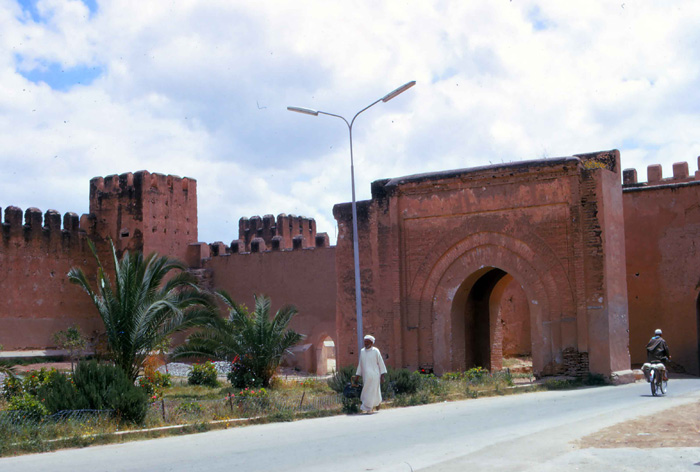
The walled city of Taroudant is known as "The Grandmother of Marrakech.
As we near the city, we are both bowled over by its crenellated towers and abundant palm trees. Taroudant exudes a sense of order and awareness of its importance in the region. Here, ochre ramparts date back to the early 16th century when the Saadi Dynasty achieved hegemony over local Berber tribes. Taroudant is especially striking sited against the high Atlas Mountains that rise in the distance. It happens to be Sunday market day and we head on foot to a noisy animal market in full swing. Among the sea of humans, wooly sheep, goats, camels and donkeys are numerous trucks and plenty of farmers noisily bartering for the best available prices. "Let's find a great place for lunch," my husband suggests after a good half hour spent dodging wandering animals. We walk past an old riad, an elegant historic house built around a central courtyard surrounded by neatly trimmed palms and fragrant roses. Tucked inside is a quiet small restaurant with a menu posted in front. Looks like they have several dishes that are worth trying," I remark. We decide to share two: braised chicken with olives and preserved lemons and lamb with prunes, each served in a traditional clay pot known as a tagine. The waiter pours us fragrant mint tea from a copper vessel held about two feet above our heads. The mint aroma perfumes the air as it cascades into our glass cups. "Hey, we need to get going," my husband announces, breaking the magic of the moment.
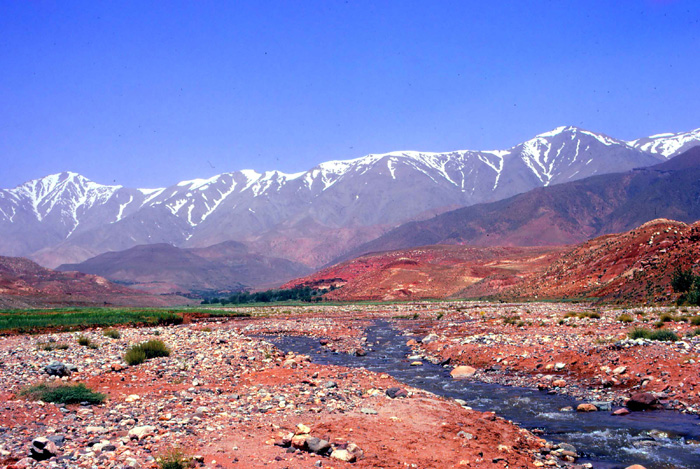
Morocco's High Atlas range remains snow-capped well into early summer.
The journey to Marrakech winds through Morocco's High Atlas range and the scenery is breathtaking at every turn, with remnants of winter snow atop its highest peaks. Without any warning, the paved road suddenly morphs into rough track made up of stones and loose earth with a few sections undergoing paving. "It's going to be tough going all the way to Marrakech. We'll have to proceed with extra caution," my husband grumbles in frustration. "I sure hope our tires hold up," I sigh. Meter by meter, we carefully make our way through the endless construction zone, losing precious time as we make our way, distracted, through spectacular High Atlas scenery. Here and there bare red mountain earth is exposed, validating its rich iron content. We pass by several derelict villages and an occasional solitary monument. Off in the distance rises Morocco's most famous imperial city. I turn toward my husband to find him smiling again. We don't have a reservation, but we decide to try La Mamounia, the city's renowned historic hotel.
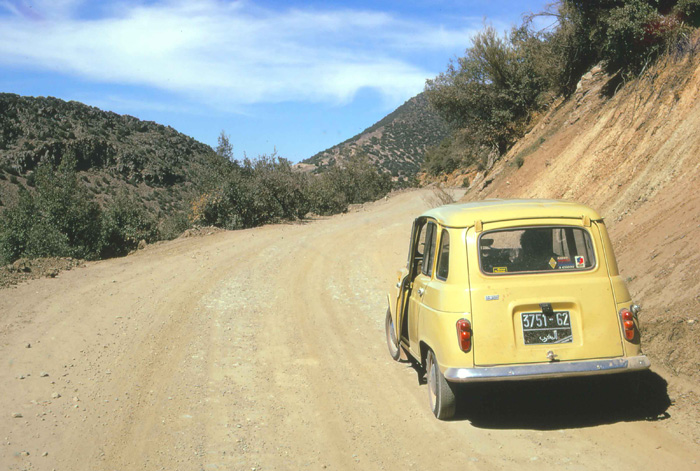
Suddenly the road to Marrakech becomes unpaved, and our Renault must muddle through.
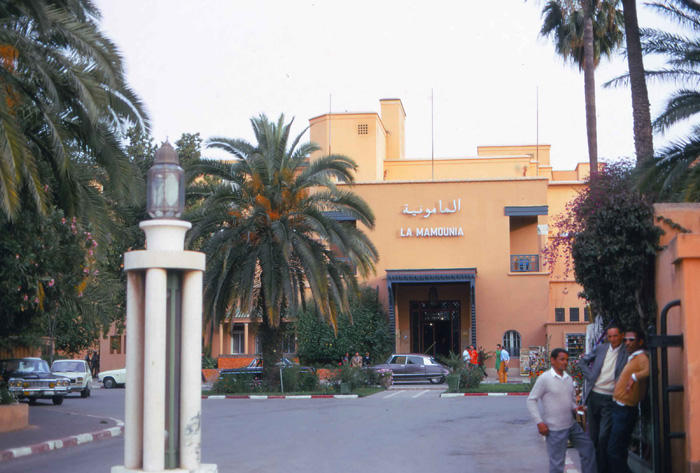
La Mamounia's magnificent gardens date back to the reign of Sultan Ben Abdallah.
Ranking as one of the world's most illustrious hostelries, La Mamounia was built in 1923, commanding a prime location just opposite Marrakech's magnificent Koutoubia Mosque. The site itself dates back to the 18th Century when Alouite Sultan Ben Abdallah gifted 13 hectares of lush orchards and gardens to his son. Those very gardens make up the hotel grounds today. I've read that the Moroccan Railway Company chose the site for the creation of a large hotel to be designed by architects Henri Proust and Antoine Marusso. The final plan blended art deco motifs and furnishings with classic Moroccan Zellige tiles and Berber tapestries. The property took the world by storm. Europeans came in droves, especially the French. It became an annual winter escape for Winston Churchill who wrote to his wife that here he could happily trade his cigars for a paintbrush. "Wasn't a famous Hitchcock film made here?" my husband asks. "Yes," I reply. "I believe it was The Man Who Knew Too Much, starring James Stewart and Doris Day." The film immediately placed the hotel on the world map and ordinary folks and politicians--from Charles De Gaulle and Franklin Roosevelt to Charlie Chaplin and Marcello Mastroianni--all came to discover it for themselves. Writers and musicians soon followed, and Paul and Linda McCartney wrote their famous "Mamunia" song during an inspired stay on the premises.
"I am afraid the only have a small room left in the back of the hotel," the man at the desk apologizes. "Can we see it first?" we ask. Not far from the hotel's kitchen, the tiny room was obviously once used to accommodate hotel staff members. We decide to take it, forgoing more luxurious accommodations at another hotel for the experience of staying on Mamounia's premises. A quick stroll through the gardens is a delight. Later at Le Marocain, the hotel's temple of Moroccan cuisine, we ask the waiter about the evening's featured dish. "Tonight we have a special couscous with steamed vegetables from our own garden, with slices of Merquez sausage and fresh herbs, he replies. "I highly recommend it." The couscous is extraordinary, fully living up to our expectations. "Please give the chef our compliments," my husband tells the waiter as he presents the bill.
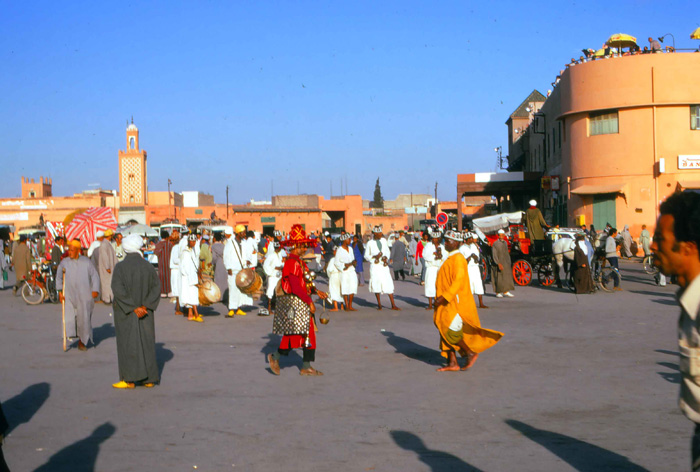
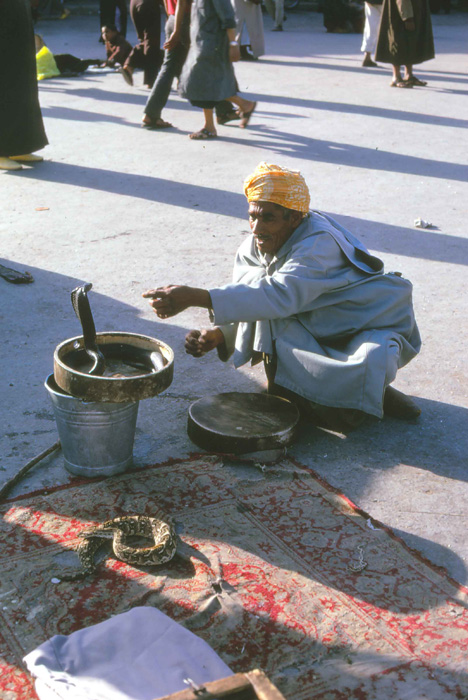
Even in early morning, Djemma el Fna, Marrakech's colorful square, is thronging with activity.
It's still morning and Marrakech's world renowned central square, Djemma El Fna, is already thronging with activity. The surreal scene exceeds all expectations, a spontaneous carnival-like mass of humanity ranging from storytellers, acrobats, snake charmers, henna artists, and juice and water sellers to exotic dancers freely swirling about, all eliciting gapes and squeals from tourists and small children who gaze in wonderment. I am intrigued by a group of men in dark blue robes and headdresses. They are known as the "blue people" from Goulimine in southern Morocco, so named because the indigo dye of their clothing rubs off on their skin. These nomads are direct descendants of Arab conquerors who arrived in the late 7th century. Very devout, they are known to turn toward Mecca every morning to thank Allah for their liberty, which they treasure above all. Two women from the group come forward, inviting us to come to a nearby restaurant in the evening where they routinely perform the "guedra" dance entirely on their knees to the hypnotic beat of a drum. "You couldn't dream up this scene if you tried," says an American woman standing near me. "For sure we have to return in the evening and eat one of the casual restaurants overlooking the square," I suggest. After a good hour of soaking in all the action, we slowly wander toward the rambling souks adjoining the square and watch craftsmen whittle wood, metalworkers smelt away, and potters deftly turn out tall clay pots. I begin to notice a terrible stench emanating from the city's adjoining leather tannery where workmen are cleaning animal hides in preparation for soaking in a line-up of vats filled with colorful dyes. A local man notices my gag reaction and seizes the moment. "I am Azam" he says. "With your permission, I suggest you step into the room of the carpet seller across from us. They will serve you some mint tea which will revive you."
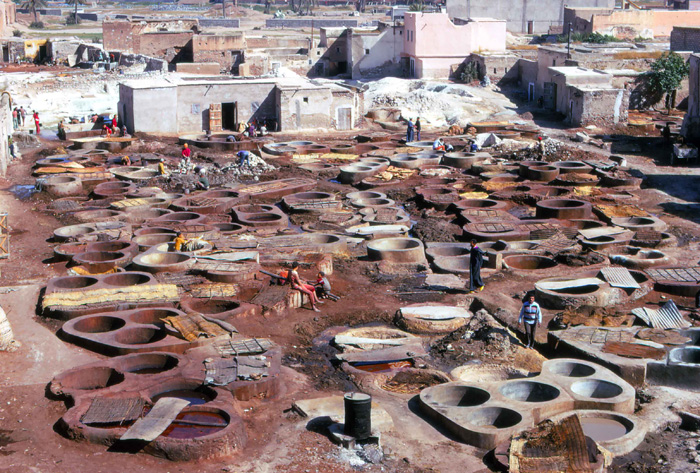
Marrakech’s dye vats are organized according to color.
Azam wasn't kidding. The tea is sweet, aromatic and restorative and the
stinking dye vats quickly become a faded memory. The showroom is filled
with hundreds of hand-made carpets, one more dazzling than the next. Two
young women are weaving carpets in a crowded back room, probably family
members. After an hour spent perusing stacks and stacks of carpets and
some spirited haggling, we end up with an antique, hand-crafted hall carpet
in vibrant gold and orange tones. "You have chosen well. This carpet
can last forever if you take proper care of it," says the proprietor
as we shake hands and prepare to leave. He rolls up the carpet in a tight
bundle and hands us a box of dry tea leaves. "When the snow falls
in America, drink this tea and you will be back in Marrakech," he
says with a twinkle in his eye.
Not far away
from the dye vats is the Mouassine Quarter, a calm area built around an
important mosque dating from the Saadian era and the jewel of the entire
medina. To fully appreciate it, you must get up close and have a look
at its green tiled roof and open courtyards. Nearby is an impressive drinking
fountain framed by three arches. Almost the entire medina of Marrakech
is made up of interlocking buildings and often it is hard to know where
one building starts and another stops. We wander toward an area of old
fondouks, the Moroccan version of a caravanserai, a centuries-old predecessor
of today's motels, where traders once lodged in small upstairs rooms built
around a central courtyard allocated to their camels. Here all the streets
are narrow and winding, a veritable labyrinth that requires the help of
a local to navigate. We are quite taken by this maze. Somehow, we end
up at the landmark Koutoubia Mosque, built during the reign of the Almohads,
the second dynasty in Morocco. It is considered a masterpiece of Moorish
decoration, exhibiting fine detailing and elegant restraint. A bevy of
local guides stand near the main entrance, ready to help swarms of tourists
who arrive non-stop. We happily latch on to Farid, an amiable young man
with an impressive command of English. "The minaret of the Koutoubia
Mosque is 253 feet tall. It has become the symbol of Marrakech,"
he says with pride. "There are eight entrances to the Mosque, but
as non-Moslems you are not permitted to go inside." "Too bad,"
I sigh, quite overcome by the intricate details of the exterior. It happens
to be the hour of a call to prayer, and we listen transfixed as a muezzin
belts out his plaintive chant from the top of the minaret.
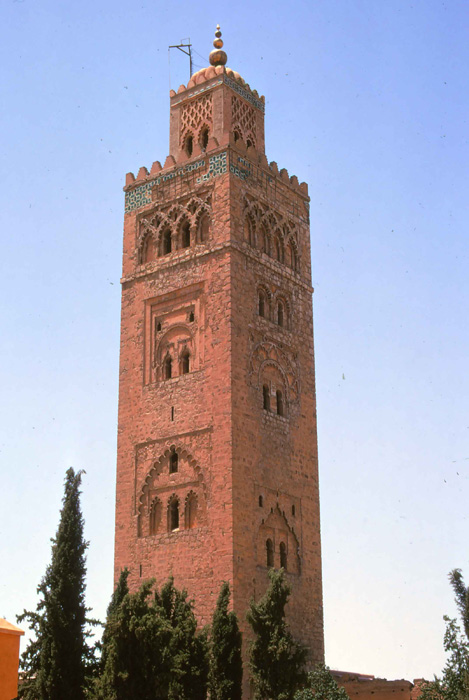
The Koutoubia Minaret is the tallest structure in Marrakech.
"Marrakech sits in an oasis of the Houz Plain at the foot of the
Atlas Mountains," Farid explains. "It has always been the city
of indigenous Berbers and various nomadic desert tribes. Specifically,
Marrakech was built by two Berber dynasties," he continues. "One
was the Almoravids of the Sahara, the other the Almohads of the High Atlas."
He leads us past the Royal Gardens, profusely planted with palms and fruit
trees. Here a giant reservoir dating from the 12th century irrigates its
lush orchards. Farid takes a moment to step outside the city walls to
Bab Agnaou, an original 12th century gateway. Made of sandstone, it is
a showpiece of interlacing arched motifs and arabesques with carved shells
in the middle. "Even though this gate has deteriorated a great deal
over the centuries, I wanted you to see it," Farid comments. "It
makes quite a statement, don't you think?"
"The
Menara Garden is one of the highlights of Marrakech," says Farid
as we walk past a scenic pavilion and artificial lake dating from the
12th Century. He leads us toward the old Jewish Quarter, known as the
"Mellah," strategically located near the imposing Royal Palace,
which offered its residents a measure of security. Dating back to 1558,
a few decades after Jews were ousted from Spain during the Inquisition,
the Mellah quickly became an important center of Jewish learning and a
colorful community with its own cuisine and traditions. The Jews of the
Mahgreb (northern Africa) lived there for centuries, until the majority
immigrated to Israel soon after it became a state. Today only a small
number remain, mostly elderly. We stroll past the Miaara Jewish cemetery,
continuing toward a crowded souk displaying artful mounds of fruits and
vegetables, ending at an aromatic spice emporium piled high with cumin,
cinnamon and turmeric.
One of Marrakech's favorite spots is the Mausoleum of the Saadian Princes,
an exquisite site in the Kasbah area of the Medina where 66 royals are
buried. It had been boarded up and forgotten for centuries until an aerial
photo revealed its existence. "It's quite something, wouldn't you
agree?" asks Farid. "Indeed," I reply, quite overcome by
of its profusion of honeycombed, gilded plasterwork and imported Carrara
marble.
Would you like to join us as our guest for dinner?" we ask Farid.
"I thought it would be fun to dine on a balcony of one of the restaurants
that overlooks Djemma El Fna," I suggest. I have read that there
you have great view of all the evening's goings-on." Farid is delighted,
breaking out in a huge smile. "Sure, nothing could be better."
We agree to meet at 8 o-clock. Farid selects a popular casual restaurant
with windows that look out to the square. We share several tangy salads
and a tagine with lamb, dates and almonds. "Delicious," I proclaim,
turning my head to the action in the square. There are several competing
live music ensembles and fortune tellers busily at work. I notice a very
busy makeshift emporium loaded with medicinal herbs under a large umbrella.
The square was crowded during the day, but at night the place is literally
pulsing with energy, the scent of cooking perfuming the very air. I look
for the Berber woman who said she would perform the Guedra from Goulimine.
She must be inside somewhere I decide. The Djemma el Fna is pulsating,
a giant party with a level of energy that says "It's great to be
alive."
It's another blue-sky morning. We head out on our own to visit a few sites that Farid had recommended: a historic craft museum with vintage blue and white ceramics, several well-tended gardens, and a few bustling souks that we had missed previously. Marrakech is dotted with many intimate riads, upscale houses that have been painstakingly restored, some including boutique restaurants. We stop at one such riad, a showcase for Moroccan tiles and traditional motifs. It specializes in small savory pastries including briouats, cigar-shaped appetizers filled with sausage or ground lamb with onions and herbs or a sweet coiled almond-filled dessert known as M'hancha (the snake). I am astonished by the variety of appetizers and desserts that are part of the national repertoire. The city continues to delight, with unexpected shops, souks, and a profusion of eateries for every taste.
Snow still
caps the High Atlas Peaks above Marrakech. We pile into our Renault, heading
in the direction of Ouarzazate, a mud-brick ksar (a fortified settlement
that is also called the "door to the desert," serving as a gateway
to the Sahara). It is dominated by a high Kasbah and has been featured
in several movies. "Lawrence of Arabia was filmed here," I remind
my husband, and the government is very amendable to having many more films
made in the area. Northeast of Ouarzazate is the rugged Todra Gorge which
we plan to explore in detail. From here a road continues deep into the
desert, lined by numerous oases of palms. We stop at Hotel Yasmina, a
delightful, moderately-priced, modern property at the foot of a rocky
massif where we plan to stay overnight. The hotel also includes a swimming
pool and abundant lounge chairs set against the pink and grey outcroppings.
Yasmina also includes a simple restaurant with popular Moroccan street
food. We take a room and are delighted to find that the accommodations
exceed our expectations. "To have the best possible experience in
the Todra area, you should start out early in the morning," the man
at the desk advises, "and take several bottles of water." "Perfect,
says my husband. I am ready to lay back and relax and soak in the desert
scenery."
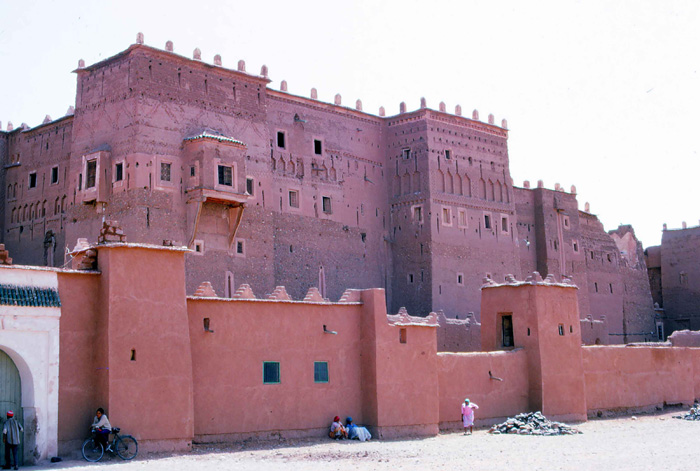
Ksar architecture (fortified village) is the signature of the Dades Valley near Ouarzazate.
Juxtaposed against red rocks and a green valley, in late April and early May the Dades area bursts into vibrant bloom and the entire area is perfumed by the scent of roses. "Roses play an important role in sacred ceremonies," I tell my husband. "Most of the roses are used in the making of bottled rosewater, an important flavoring in Moroccan cooking, especially in coiled pastries." Even from our hotel, the scent of roses seems to perfume the very air. We drive into the town of El Kelaa M'gouna. Near here a bite at Chez Pierre is just what we need. Sinuous bushes cut a trail of green against the rugged outcroppings. "The place is very exotic," I proclaim." We drive past a group local women, hunched over and busily gathering rose petals to be shipped to local factories. It is a breathtaking drive, and we feel privileged that we are able to include the gorges in our desert exploration. "Let's get to bed early tonight," my husband advises. "We have a very long drive tomorrow to Fez."
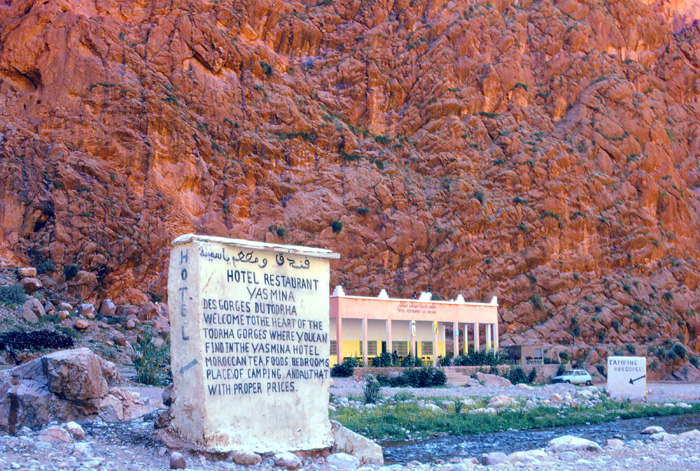
Hotel Yasmina is a welcome oasis amid the rock formations of the Todra Gorge.
The sun seems extra bright in the morning. We enjoy some French pastries
and fresh fruit before heading out in the direction of Fez. We seem to
have to the endless desert road all to ourselves. The drive takes us through
Rissani, passing through Erfoud and Col de Zad, finally reaching Fez several
hours later. Our plan is to stay at the Palais Jamai, a palace that was
built in 1879 by Si Mohammed ben Arbi El Jamal, a grand vizier of Sultan
Moulay Hassan I. Over the decades, the palace ultimately evolved into
a luxury hotel under the ownership of the Company of Railways of Morocco.
But that is a story for another time…
